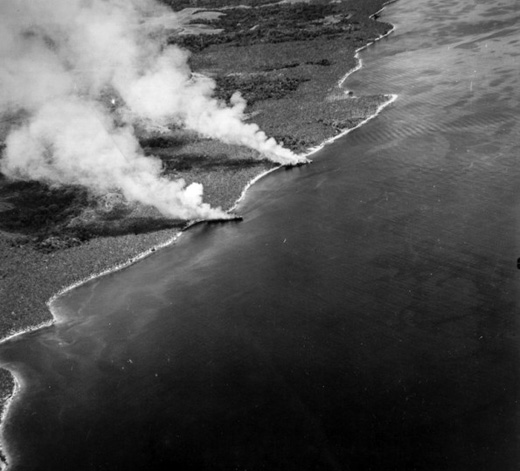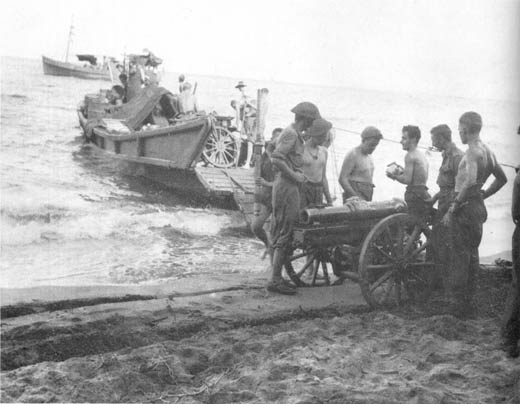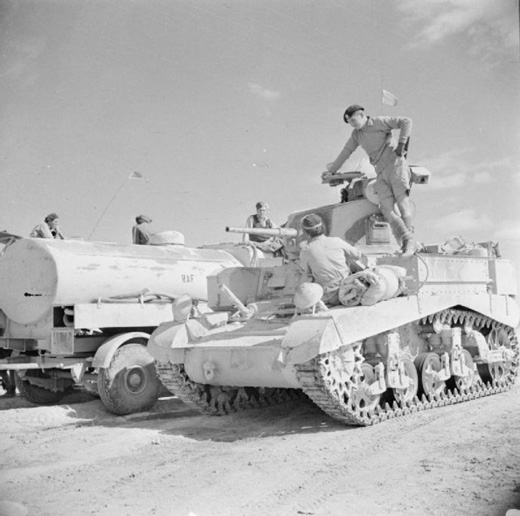Air Operations, Bismarcks
V Bomber Command B-17s attack shipping at Rabaul.
[Air Operations, Europe
Hampdens of the Royal New Zealand Air Force attack shipping off the Norwegian coast.
BOMBER COMMANDEvening Ops:
- 78 aircraft are sent to Genoa: 40 Halifaxes, 27 Lancaster and 11 Stirlings.
- The bombing is reported as accurate, but there are no details.
- There are no losses.
- 22 Wellingtons of 1 Group lay mines off La Pallice, Lorient and St Nazaire; 1 Wellington is lost.
Air Operations, Libya
Two small formations of IX Bomber Command B-24s sent to attack Tripoli are prevented from reaching the target by bad weather. One group, however, attacks a motor convoy, an airdrome and road traffic.
[Air Operations, New Guinea
V Bomber Command B-25s and 22nd Medium Bomb Group B-26s attack antiaircraft emplacements at Buna and Soputa and 3rd Light Bomb Group A-20s attack ground targets near Gona.
[Air Operations, Solomons
- Cactus Air Force and Carrier Air Group 10 bombers and fighters attack the 4 surviving Japanese Navy transports, which have been intentionally beached near the western end of Guadalcanal. Numerous hits are scored on the transports, which are reduced to hulks as the day progresses. This concludes the decisive Naval Battle of Guadalcanal, following which the Japanese Navy’s Combined Fleet ceases to be a factor in the South Pacific campaign. After November 15, 1942, the Japanese commit no more transports and no warships larger than destroyers to the defense of Guadalcanal, and Japanese Navy aerial opposition falls to inconsequential levels.
- During the early morning, 2 VMF-121 F4Fs shoot down 2 A6M2-N 'Rufe' fighter-bombers over Guadalcanal, and VF-10 F4F pilots operating from Figther-1 airfield on Guadalcanal down 6 A6M Zeros or A6M2-N 'Rufes' over Guadalcanal at 1520 hours.
Atlantic
- The British escort carrier Avenger, escorting Convoy MKF-1Y is sunk by U-155 about 120 miles northwest of Gibraltar. There are only 12 survivors of the 526-man crew. They are picked up by the Norwegian destroyer escort Glaisdale.
- The British anti-submarine whaler Ullswater (555t) is sunk by a German motor torpedo boat in the English Channel with the loss of 35 crewmen.
Battle of the Atlantic
U-98 is sunk west of Gibraltar by depth charges from the British destroyer HMS Wrestler.
| Class | Type VIIC |
| CO | Oberleutnant zur See Kurt Eichmann |
| Location | Atlantic, W of Gibraltar |
| Cause | Depth charge |
| Casualties | 48 |
| Survivors | None |
Britain, Home Front
- Church bells ring throughout Britain to celebrate the victory of the 8th Army at El Alamein. The BBC broadcasts the sound of bells worldwide.
- On 'Civil Defense Day' the King inspects a parade of 1,500 in London.
Guadalcanal
The last 4 of the 11 Japanese transports which should have landed reinforcements and materials on Guadalcanal are sighted at Tassafaronga, west of the American perimeter, and attacked by American aircraft and naval and land-based guns. Of the 4 surviving Japanese transports, 3 are beached and unloaded, while the 4th is slowly pulling northward toward Doma Reef. As the transports hit the beach, the men scramble over the sides with just their rifles and a little bit of rice. They begin climbing the mountain trail built by the Pioneer Forces, through the jungle to the main encampment of the Japanese command.
Japanese Transports On Fire |
 |
Battery F, 244th Coast Artillery Battalion, moves 2 of its guns from their positions on the west bank of the Lunga to the beach. At 0500 these 2 open fire and hit one of the beached transports 19,500 yards away. It begins to burn. 45 minutes later the 3rd Defense Battalion's 5-inch batteries open fire on a second ship 15,800 yards away and hit it repeatedly. The destroyer Meade sails over from Tulagi to shell both ships and landing areas. Before 0600 American planes look down on the grounded transports: Kinugawa Maru, Yamatsuki Maru, Hirokawa Maru, and Yamaura Maru. Adm Kusaka sends from Bougainville as many fighters as he can to protect the transports on the beach. The first raid scores hits on two of the transports. The second raid half an hour later hits more of them and a third at 0700 hits supplies on the beach. Five more attacks are made on the Japanese ships and they burn. Kusaka sends more Zeros but F4Fs engage them over Savo and claim 7 planes shot down to a loss of one. By noon all 4 are burning, useless hulks which are abandoned.
No more than 2,000 men are able to land; 2,000 more are killed on the beach, or trying to reach it. This is the last time the Japanese try to reinforce the island on any considerable scale. Japanese effectives on Guadalcanal at this time number about 20,000, though many of them are seriously ill with beri-beri and various forms of dysentery. There are about 23,000 Americans on the island.
Only 4,000 of the convoy's 10,000 troops land safely on Guadalcanal. Virtually no supplies make it, only 5 tons of the expected 10,000. Although some of the troops drown, many are rescued by the Japanese. The destruction of the convoy brings the November counteroffensive to an end.
Back at Nouméa Halsey can claim a clearcut victory. The Japanese had set out to land 10,000 men, plus the heavy equipment, big guns and ammunitioin for an entire infantry division. Only about 2,000 actually get ashore, with 1,500 bags of rice, 4 days supply, and 260 rounds of ammo for the mountain guns. The cost to the Japanese: 2 battleships, 1 heavy cruiser, 3 destroyers, 77,609 shipping tons in the 11 transports and about 50 planes plus 6 damaged warships. The Americans landed the 8th Marine Regt from 4 transports which had then retired. American losses: 2 cruisers, 7 destroyers and serious damage to 3 cruisers and lighter damage to a battleship. It is costly for both sides, but the Americans have the best of it.
[Mediterranean
The British minesweeper Algerine is sunk by the Italians submarine Ascianghi off Bougie, Algeria with the loss of 80 of her crew.
[New Guinea
Having built rudimentary bridges over the Kumusi the Australians are able to advance to take Wairopi and Ilimow.
Australian Troops Loading Guns |
 |
North Africa
ALGERIAThe British 36th Bde, 78th Div, of the 1st Army crossed the Tunisian frontier and captures Tabarka, on the coast about 75 miles from Tunis. The 2nd Battalion, 509th Parachute Regiment, takes Youks-les-Bains, near Tébessa in Algeria, about 95 miles south of Bône.
LIBYAThe British X Corps occupies Martuba airfield.
Refuelling a Stuart Tank |
 |
The German buildup has been very rapid and there are now 10,000 troops taking up positions in Tunisia. They have over 100 combat planes in bases long established by the French, convenient for the front and with all-weather runways. The Allied air forces are forced to use temporary landing grounds farther from the front.
[